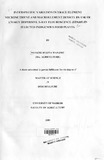| dc.description.abstract | Many indigenous cultivars have disappeared within the lifespan of the present generation. In many areas, diets are based on fewer plant species. This coupled with increased population, low incomes and a misguided preference for expensive exotic foods, has contributed significantly to the problem of micronutrient malnutrition (hidden hunger), and increased levels of poverty and food insecurity in the country.
To plan national programs and strategies, data on the nutritional value of the indigenous food plants is required because they are a regular component of diets to many people.
One of the most efficient methods of improving the yield and nutritional value of subsistence crops is to improve the land races or weedy species being grown through selection or breeding. In order to accomplish this, genetic stocks/germplasm must be available for characterization. Unfortunately, systematic genetic collections on indigenous crops and an efficient analytical tool are lacking locally. Furthermore, many of African leafy vegetables, cereals and fruits so far known are so large that extensive characterization could be difficult as the numbers of samples that can be effectively evaluated for intrinsic characters such as micronutrient density are limited. Sensitive analytical techniques are therefore essential when preliminary assessment of quality might be important at germplasm level.
Germplasm characterization has traditionally been done by wet chemistry procedures. These procedures however, are expensive and time consuming. They also require laboratory skills and apparatus. Physiological techniques require expensive standards for calibration, can be also tedious and may not be practical especially at inter and intra-specific levels. Consequently, such procedures are not suited to screen/characterize a large number of germplasm samples.
Energy Dispersive X -Ray Fluorescence gained appeal as the method of characterization in that it is a nondestructive, rapid, multielement technique on which analysis can be done on microgram quantities across a large range of matrices i.e. solids liquids and solids. The method does not require standards for every element analyzed.
Traditional African agriculture employs a crop genetic diversity of a type, which embraces growing a variety of cultigens and/or marginal plant species (wild or semi cultivated). Due to consistent adaptability, many native types in use appear to posses’ efficient mechanisms with which to extract the little available nutrients and concentrate them in their tissues during their growth and development. Due to their genetic differences and species extent of uptake, tissue concentration varies With respect to these variations; there possibly exists a genetic diversity in phyto-micronutrient density, which at present time would be important if characterized by any known procedures.
A reconnaissance was carried out in three locations of Kenya; Mt. Elgon region, Lake Victoria region and Eastern region to characterize by Energy Dispersive X-ray fluorescence Spectroscopy (EDXRF) for inter-specific variation in micronutrient density in germplasm of selected indigenous vegetables, cereals and fruits. The purpose was to characterize thirteen indigenous species of plant samples falling under three categories: vegetables, cereals and fruits. The thirteen indigenous species of plant falling under the category of Useful African Crop Plants (UACPs) were collected namely: maize, finger millet, pearl millet, sorghum (cereals) cowpea, African nightshade, bush okra, spider weed (vegetables), Jackfruit, Rhus spp, Fichus spp and Grewia (indigenous fruits) and characterized for inter and intra specific variation in micronutrient density in respect to hidden hunger alleviation. In the laboratory, two macro- elements (MAEs) were determined; potassium (K) and calcium (Ca), and four trace micronutrients (MIEs) as iron (Fe), zinc (Zn), manganese (Mn) and copper (Cu) on germplasm and its corresponding soils from sites of collection.
Populations of both plant and the corresponding soil material from three separate sites for each type of the eleven species were obtained from Mt. Elgon and Lake Victoria region while only five species were obtained from the eastern region of Kenya.
EDXRF raw data was empirically converted into characterization data and complete randomised design (CRD) used as the method for data analysis by Genstat statistical package. Pearson’s ‘r’ was used to give correlation trends among the soil and plant macro and micronutrient elements.
After Energy Dispersive X -Ray Fluorescence analysis it was found out that there was significant variation (P<0.05) in micronutrient density in respect to hidden hunger alleviation (MINU-HHA) variation among UACPs accessions even where grown under similar conditions. The vegetable categoiy had significantly (P<0.01) the highest micronutrient and macro element levels compared to the fruits and cerealsSoil macro and microelement concentrations differed from different sitessignificantly (P^O.Ol).
The interaction between species and sites in micronutrient and macro element content was significant (P<0.01) indicating a strong genotype-macro and micro nutrient content interaction in populations sampled.
The variations in MINU-HHA imply a strong environmental modulation on the genotype to the extent that such variation was not only regional specific but soil specific as well.
Field population values without some kind of a standardization procedure (in light of the interaction component) are less informative with regard to the specific genotypic micronutrient and macro element contribution to hidden hunger. Separation of the genotype from the edaphic connection is in effect necessary in order to target the genetic potential for improving the farmer- preferred populations. The interaction further suggests the need to consider soil macro and microelement
management in farming with the indigenous resources.
The variations in MINU-HHA also imply that dietary diversity is important for nutritional
adequacy. | en_US |



